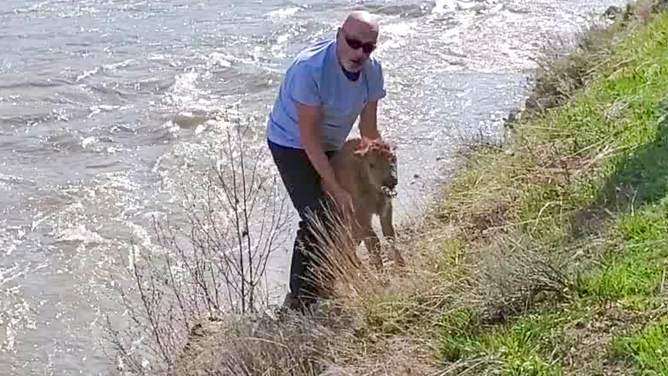Hawaii man fined following death of bison calf at Yellowstone National Park
Park rangers said they were forced to euthanize a bison calf after a man pushed it up a river's embankment, likely causing it to be rejected by the herd.
Watch: Bison calf holding up traffic in Yellowstone National Park
A bison calf holding up traffic in Yellowstone National Park, Wyoming, was watched over by its herd while sitting in the middle of a road, on April 22.
MAMMOTH HOT SPRINGS, Wyo. – A man spotted trying to help a newborn bison in Yellowstone National Park in May pleaded guilty in federal court Wednesday after authorities said they had to euthanize the animal because its herd rejected it.
Clifford Walters faced one count of feeding, touching, teasing, frightening, or intentionally disturbing wildlife and will have to pay a fined $500 fine and a series of other fees.
According to the U.S. Department of Justice, while in the park, the Hawaii resident pushed the struggling bison calf up a river’s embankment and onto a nearby roadway.
No evidence of malicious intent was found, but after the encounter, park staff said the calf began to try to befriend people and follow cars, which created a hazard.
The park said rangers repeatedly tried to reunite the calf with the herd, but likely because of human interference, the offspring was rejected.

An unidentified white male in his 40-50's, wearing a blue shirt and black pants, approached a newborn bison calf in Lamar Valley near the confluence of the Lamar River and Soda Butte Creek in Yellowstone National Park.
(Hellen Jack)
TOURIST TAKES DANGEROUSLY CLOSE SELFIE NEXT TO BISON IN YELLOWSTONE NATIONAL PARK
In the days after the incident, park staff said they were faced with no other options than to euthanize the bison.
The park’s actions triggered an uproar by guests and social media users asking if there was a better to handle the situation.
The National Park Service released a lengthy statement that, in part, read, "We made the choice we did because national parks preserve natural processes."
JOGGER’S PREHISTORIC FIND ALONG CALIFORNIA BEACH WOWS MUSEUM COLLECTORS
Rangers are using the incident to remind visitors that approaching wild animals can impact their well-being and survival.
Federal regulations require that people stay at least 25 yards away from wildlife such as bison, elk and deer and at least 100 yards away from bears and wolves.
The country’s oldest national park attracts more than 3 million visitors annually and is one of more than 400 sites managed by the National Park System.
